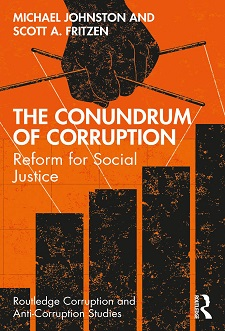The Conundrum of Corruption Reform for Social Justice
Clay G. Wescott | 05 August 2021
Book Review
The Conundrum of Corruption Reform for Social Justice
By Michael Johnston, Scott A. Fritzen
New York: Routledge. 2020.
One of the authors had a paper turned down for a 1987 conference because studies of corruption weren't considered to raise important theoretical or methodological issues. How things have changed today! Or have they? On the one hand, there are corruption scorecards, rankings of all colors, and an endless stream of academic and practitioner research analyzing the flood of recent corruption data. But what is the outcome of all this sound and fury?
The authors find that much of the framing and analysis is too monochromatic to get at the heart of things, with five misleading categories. First, corruption is everything bad. Take the Transparency International annual rankings: they first started with public opinion surveys, then brought in business and expert surveys. Because the evidence base changed over time, one couldn't usefully compare national ratings over time. While these and similar rankings brought more attention to corruption, they were difficult to use for meaningful analysis. By lumping together all forms of bad stuff, they made it hard to understand any part. They also lumped together bad stuff of a large country that might have wildly different enabling conditions in various regions, sectors, and localities, all affected differently by varied regional and global enablers. The different types of corruption have varying enabling conditions, interconnections, and consequences that are hard to disentangle. As Morris (2021) observed, it’s like a public health specialist trying to analyze the spread of "illness" in a country, rather than the spread of particular diseases like COVID-19.
A second unhelpful framing is corruption as deviance. For example, if corruption means breaking laws, how does one interpret legalized corruption where the powerful pass laws to protect their corrupt behavior. A third framing is oversimplifying. Corruption may be defined as bribery with a quid pro quo; but what if the whole system is rigged against most people, and corruption is endemic throughout the system? In many places, you stop it in one area, then it pops up in another. The Philippines put an e-customs system in place to curtail corruption by preventing face to face meetings; corruption levels stayed the same, but payments were made instead to the guards at the gateway, who then gave most of the payment to the customs officer that had been paid directly by the importer before.
A fourth framing is corruption as a national or cultural trait. Again, this assumes uniformity across sectors, and localities where incentives and behavior may be very different. And finally, corruption is unhelpfully viewed as backwardness; national rankings show poorer countries as the most corrupt, but this is largely due to the way the issue is framed. Could Isabel dos Santos and her cronies loot billions from Angola without the help of a global system of bankers, accountants, lawyers, and other enablers to keep the loot confidential and protected in countries with good rule of law?
Drawing on these monochromatic framings, reformers, supported by the anticorruption industry of contractors and academics, often go for magical narratives and “silver bullets”: actions thought to reduce corruption by themselves. This rarely works without adjusting for the specific reform context. One such bullet is “crime and punishment” including setting up an anticorruption agency (ACA). More than 100 countries have them. Although this worked in Singapore and Hong Kong, where ACAs got silver bullet status, there’s little evidence of benefit from the others. In most cases, drop an ACA on a corrupt society and you get a corrupt ACA, or at best a toothless one. Another silver bullet is strengthening markets, strengthening local government, and cutting back centralized state power to fight corruption.
The authors have uncovered many sound reasons why our analysis and anticorruption measures have underperformed. But they also missed a few. Morris (2021) shows how corruption framing, including some of the magical narratives discussed above can be driven by political ideology: to those on the right, corruption stems from incentives and distortions of market forces. Businesses are the victims of unlawful officials. The solution is to cut back the state, and make the remaining parts work better. On the left, market failure is the problem. Businesses are the corrupt agents rather than the victims, colluding with politicians to adopt a regime of legalized corruption. The solution is profound effort to confront and change the imbalance of power and exploitation of the many by the few.
In Morris’s terms, a key Johnson and Fritzen recommendation is to move beyond the approach of the right to embrace the approach of the left. Yet Morris finds that while leftist regimes have had some success combatting corruption using their approaches to confront and change the imbalance of power, overall progress is disappointing. Morris concludes that the main problem in the Americas of both the left and right is that those out of power frame as corrupt the behavior of those in power. Once the tables have turned, they switch roles, and the same corrupt practices continue with new beneficiaries.
Where does that leave the anticorruption industry? They need to constantly challenge magical narratives and silver bullets to find out what works best, taking into account the enabling conditions embedded in the history, divisions, politics and economics of complex societies. They should enhance social justice, take a patient, long term perspective with incremental experiments, take on risk and uncertainty, make mistakes, monitor and evaluate, learn not to repeat the same mistakes and embrace serendipity.
Reference
Stephen D. Morris. 2021. The Corruption Debates: Left vs. Right—and Does It Matter—in the Americas.
Boulder, Colorado: Lynne Rienner Publishers.
Clay G. Wescott, President, International Public Management Network and member of international Advisory Board at Centre for Governance Studies (CGS).
